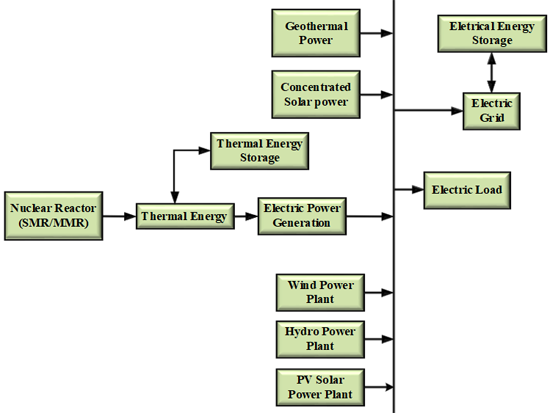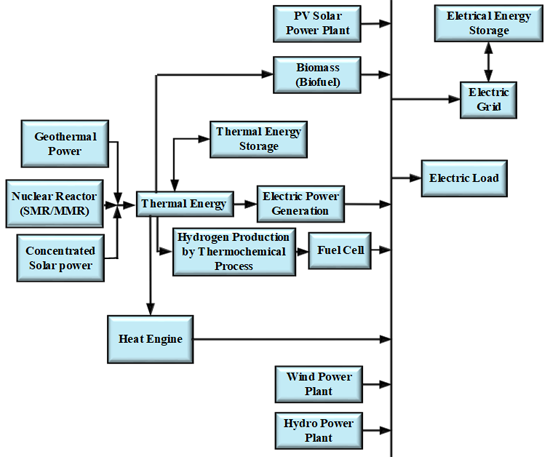Grid-Connected Nuclear-Renewable Micro Hybrid Energy System
By Hoassam A. Gabbar and Muhammad R. Abdussami
There is a number of initiatives to integrate nuclear and renewable technologies to provide high-performance energy systems with maximum utilization of nuclear power plant resources as well as to achieve balanced energy generation to meet load profiles and demands. However, there is a number of challenges to achieve practical and profitable Nuclear- Renewable Hybrid Energy System (N-R HES), such as scalability, capital cost, project lifetime, construction period, land acquisition, ecological safety, and technological barrier. There are possible ways to overcome some of the challenges of N-R HES by introducing small scale nuclear reactor, called Small Modular Reactor (SMR) or Micro Modular Reactor (MMR). The Nuclear-Renewable Micro Hybrid Energy System (N-R MHES) offers to combine the small scale of Nuclear Power Plant (NPP) with Renewable Energy Sources (RES). The byproduct of the N-R MHES, the thermal energy, is also used in an efficient way to support the thermal load, district heating, hydrogen production plant, heat engine, absorption chiller, etc. The N-R MHES offers the possibility of different coupling options between input and output of the system. The nuclear- renewable integration criteria depend on the availability of the RES and the consumer load demand. The N-R MHES fits best to the remote consumer having an adequate amount of electric and thermal load. The grid-connected N-R MHES provides the opportunity to purchase the electricity in case of emergencies and to sell the surplus energy of the N-R MHES to the grid. In case of unavailability of the grid, an energy storage system can be used to store the surplus energy.
Nuclear-Renewable Micro Hybrid Energy System
The nuclear-renewable integration can be carried out in two ways: large scale and small nuclear-renewable integration. If the RES based power generation systems are installed around the traditional large NPP, it is called large scale nuclear-renewable integration. When the small scale nuclear power, such as SMR or MMR, are moved to the site of RES and integrated with RES based power generation system to support the local electricity demand, it is called small scale nuclear-renewable integration; it is also named as “N-R MHES”. Previously, it was thought that only renewable source is capable of supporting the electricity demand to the remote area. But, due to the irregularity of the RES, it is quite difficult to fulfill the local electricity demand all the time. Moreover, grid-connected N-R MHES makes a worthy solution for large industry, office, and university; it reduces the dependency on grid and lowers the energy cost. Research simulations estimate the criteria and help to choose the appropriate energy system depending on electricity load profile.
Table I. Criteria and Energy System Selection
| Types of Electric Load | Types of Energy System |
|---|---|
| Low electricity demand | Standalone RES-based MEG |
| Medium electricity demand | Standalone MMR-based MEG |
| Large electricity demand | N-R MHES |
The N-R MHES intends to provide electric and thermal power to the community. The multi-level nuclear-renewable coupling is possible. The N-R MHES includes SMR/MMR, RES, electric energy storage, and thermal energy storage. The N-R MHES also includes electric power grid, but the introduction of the power grid is optional; it depends on the site and situation.
There are mainly four types of coupling method in nuclear-renewable integration:
i) Loosely Coupled
In this process, the RESs are combined with a nuclear reactor and the main consideration is to the electricity generation. The RES and nuclear reactor generate electric power separately and they are linked together at the electricity distribution level. The combined system may supply the surplus electricity to the electric grid. Hence, N-R MHES can be connected with the electric grid as well.
Fig 1. Loosely Coupled N-R MHES
ii) Multiple Tightly Coupled Products
Here, the nuclear reactor is integrated with renewable energy which is also yielded by the nuclear power inside the N-R MHES. In this type of coupling, no external RES are combined with a nuclear reactor. The heat and electric power from the nuclear reactor produce some RES, such as biomass, hydrogen gas, etc., which are integrated with the nuclear reactor to supply electric power. In N-R MHES, the hydrogen and biomass are considered as RES.
Fig 2. Multiple Tightly Coupled Products N-R MHES
iii) Multiple Tightly Coupled Resources
This kind of coupling offers two level energy integration; that is thermal and electric level coupling. There are some RES, such as geothermal power source, concentrated solar power source, etc., which produces a considerable amount of thermal power; this thermal power is added with the nuclear reactor thermal power to generate electricity. Moreover, in the electric level coupling, the electricity generated from a nuclear reactor is linked with the electricity, produced from other RES (wind, solar, hydro, biomass, etc.). An electric grid is also connected to the N-R MHES to take surplus electric energy or to supply electricity to the N-R MHES in an abnormal case. However, the focus of this coupling method is to generate electricity.
Fig 3. Multiple Tightly Coupled Resources
iv) Tightly Coupled
In tightly coupled method, all form of energy mixes with each other for maximum utilization of the available energy in the N-R MHES. All thermal energies are added together and all electric energies are combined together; then all forms of energy are used in the most efficient way. The available thermal and electric energy is used in all possible applications, such as seawater desalination plant, fuel cell, district heating, heat engine, calcination, etc.
Fig 4. Tightly Coupled N-R MHES
A hybrid system may not include all types of RES. The heat generated from N-R MHES is generally used for the industrial purpose; whereas, the generated electricity from the hybrid system is used to support the electric demand. The surplus energy produced from the system can be supplied to the grid and remunerated by “net metering”. If necessary, electric energy can be drawn from the grid and combined with the heat to support the industrial load (e.g. hydrogen demand). Advanced energy storage system plays a very important role in the N-R MHES. A dynamic control strategy is adopted in the N-R MHES to maximize the efficiency of the system.
For a downloadable copy of August 2019 eNewsletter which includes this article, please visit the IEEE Smart Grid Resource Center.

Dr. Hossam A.Gabbar is Professor in Ontario Tech University (UOIT) in the Faculty of Energy Systems and Nuclear Science, and cross appointed in the Faculty of Engineering and Applied Science. He has established the Energy Safety and Control Lab (ESCL). He is the recipient of the Senior Research Excellence Aware for 2016 with more than 220 publications. He is leading national and international research in the areas of smart energy grids and resilient transportation electrification. Dr. Gabbar obtained his B.Sc. degree in 1988 with first class of honor from the Faculty of Engineering, Alexandria University (Egypt). In 2001, he obtained his Ph.D. degree from Okayama University (Japan). From 2001 till 2004, he joined Tokyo Institute of Technology, as a research associate. From 2004 till 2008, he joined Okayama University as a tenured Associate Professor. From 2007 till 2008, he was a Visiting Professor at the University of Toronto.

Muhammad R. Abdussami is a graduate research student at the Faculty of Energy Systems and Nuclear Science, University of Ontario Institute of Technology, Canada. Currently, he is doing an M. A. Sc. on nuclear-renewable integration system. He holds a bachelor degree in Electrical and Electronic Engineering from Islamic University of Technology, Bangladesh. He is very excited about the innovation of Nuclear-Renewable Micro Hybrid Energy Systems. His research interests include Nuclear Power, Renewable Energy, Smart Energy Grid, Nuclear-Renewable Integration Systems, and Advanced Energy Storage Systems.
To have the Bulletin delivered monthly to your inbox, join the IEEE Smart Grid Community.
Past Issues
To view archived articles, and issues, which deliver rich insight into the forces shaping the future of the smart grid. Older Bulletins (formerly eNewsletter) can be found here. To download full issues, visit the publications section of the IEEE Smart Grid Resource Center.








